Caty Borum Chattoo
Co-Director, Center for Media & Social Impact
Executive in Residence, American University School of Communication
with
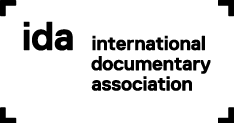
The International Documentary Association
September 2016
OVERVIEW
The Documentary Field at a Moment of Opportunity & Challenge
While documentary storytelling has long enjoyed a vibrant space in the media ecosystem – crossing fluidly between journalism and entertainment – the industry may be enjoying the early days of an evolving digital golden age. Documentary production, distribution and consumption practices have changed, in some ways radically, over the past few decades. The new century ushered in accessible digital production, new TV distribution opportunities, virtual reality, transmedia storytelling and a revolution in audience consumption via online streaming and on-demand viewing. Increasingly layered distribution strategies – including festivals, theaters, TV, community-based and online – provide a pathway for documentaries to enjoy a longer and more dynamic life cycle with multiple audiences than ever before.
The evolution in form, audience demand and distribution will continue as new filmmakers enter the art and business of documentary production. The key players in the documentary field often are diverse hyphenates, wearing multiple hats on the same projects, from fundraising to writing to shooting to editing to marketing and more. The documentary ecosystem includes independent producers who create films while making a living through other means, to full-time makers, to distributors and funders, all of whom together shape the industry.
And yet, despite new opportunities for documentary filmmakers and audiences, particular challenges are persistent. Questions about sustainable systems and sources of revenue that can support career-making documentary work continue to plague makers of all kinds. Issues of racial, gender and ethnic diversity – both in terms of the credited makers themselves, as well as the focus of the stories told – continue to challenge the business and art of documentary filmmaking, dispelling the myth that the system of independent documentary filmmaking is markedly distinct from similar circumstances facing scripted Hollywood entertainment in film and on TV. As new audiences continue to discover documentary storytelling across various platforms, tracking industry professionals’ perspectives and lived experiences in the field is a vital pursuit.
ABOUT THE STUDY
Given the opportunity and challenges of the moment, the timing is right for the inaugural “State of the Documentary Field” trend study to reflect the perspectives of documentary industry members. The study will be repeated bi-annually to provide trend data and new ideas over time.
Content Focus
This report reveals the results of a survey of documentary professionals conducted in the United States in 2016. The questions, crafted by the report author in consultation and collaboration with the leadership team from the International Documentary Association (IDA) – Simon Kilmurry, Ken Jacobson, and Amy Halpin – were shaped based on informal insight gathering and conversations with documentary professionals across the country. The survey included approximately 20 content questions and seven demographic questions. The study was designed to understand documentary industry members’ perspectives and lived experiences based on four key themes that emerged as paramount to the field:
- CHALLENGES & MOTIVATIONS: The Present & the Future
- CAREERS & FUNDING: Sustaining a Documentary Career & Funding the Work
- DISTRIBUTION & FORMAT: Getting Seen
- DIVERSITY & INCLUSION: Race & Gender On and Behind the Camera
Fielding Protocol & Dates
The survey was hosted online on Fluid Surveys (Survey Monkey), and the IDA facilitated online data collection with documentary industry members; data collection began at the Sundance Film Festival on January 24, 2016, and it continued over the next several months via outreach to the IDA membership list (documentary filmmakers and other industry professionals) and social media channels from January through September 2016.
Composition of Respondents
The survey was completed by about 580 respondents as of September 5, 2016. The respondents comprise a range of documentary professionals – directors, producers, editors, directors of photography, as well as non-profit professionals, film festival professionals, funders and others. However, the survey primarily represents the perspectives of those who identify as directors and producers. Participation in the survey was voluntary, and respondents were not provided with incentives. [Future efforts to secure respondents can and should include additional focus to increase full participation and survey completion by the documentary film community, perhaps with respondent incentives and marketing support; this study and report writing was not supported by any external funders – it was completed as an enterprise project.]
Summary Findings & Analysis
Summary findings for the primary questions are offered in this report. Deeper analysis broken down by gender is shown where notable distinctions appear (gender-based samples are similar in size). In terms of racial identification, sample sizes are markedly lower for non-white respondents, so accurate conclusions about differences between racial groups aren’t possible with this data.
HIGHLIGHT FINDINGS & DEMOGRAPHICS
Challenges & Motivations:
- By far, documentary film professionals see making a living as the most pressing issue facing the industry. They see the greatest challenges as funding for documentaries and sustainable careers, with more than two-thirds (67%) indicating these two categories are the “most challenging issues” today.
- Despite challenges, documentary professionals view this as an exciting time in the field. Eight in 10 (83%) agree or strongly agree that they are excited about the future of documentary. About two-thirds (64%) feel strongly this is a “golden era” for documentary.
- In terms of specific trends in the field, documentary professionals are most optimistic (“very optimistic” and “optimistic”) about: (1) new opportunities for online distribution (94%), (2) documentary’s social impact (92%), (3) Web-based short-form documentaries (90%), and (4) new audiences discovering documentaries (90%) to watch. They are least optimistic about the distribution of documentaries in theaters (62 percent “not optimistic” or “not at all optimistic”) and crowd-funding for their work (41%).
Careers & Funding:
- Only about 22 percent of documentary professionals say they are able to make their primary living from documentary filmmaking; about three-quarters (78%) say they are not at all able to make a living from their documentary work.
- Combined, more than two-thirds (66%) of documentary makers made either no salary at all (36%), or less than 50 percent of their salary (30%), from their most recent documentaries.
- Half of the documentary film professionals surveyed report spending $5,000 to $50,000 on their most recent documentary projects. More than a quarter (27%) spent between $20,000 and $50,000 to fund their documentary work.
- Foundation grants remain the top option as a main source of documentary funding (33%), followed by personal finances (24%) and broadcast and cable TV licensing deals (21%). Entities that are not at all sources of documentary funding, according to these documentary professionals, are: Film studios, online streaming platforms and corporate funders.
- Documentary film professionals find revenue from their documentary work through a mix of non-film-industry sources and some traditional industry streams. About 61 percent of documentary professionals say educational distribution and DVD sales are tied at the top of the list for revenue from documentary work (as a contributing or main source of revenue). Other top revenue streams (as contributing or main sources of revenue), in order, are: grassroots and community screenings (52%), speaking engagements (49%), international TV broadcast licensing (46%), and self-distribution (44%).
Diversity & Inclusion:
- Despite recognized challenges of achieving greater levels of racial and gender diversity both in documentaries and among the individuals who make them, documentary professionals see the most progress in the representation of people of color in documentary stories (83% see this as “some” and “a great deal” of progress).
- Documentary professionals see the greatest challenge in this area in terms of people of color as producers and directors: Almost half (47%) believe there’s been no progress or not much progress on the inclusion of directors of color, and 56 percent feel the same way about including producers of color.
- In terms of gender, 87 percent of documentary professionals believe “some” and “a great deal” of progress has been made for documentary producers who are women, and 84 percent of documentary professionals believe the same for women documentary directors.
Distribution & Format:
- Most documentary filmmakers still predominantly create long-form stories (feature-length or :60 broadcast length); more than two-thirds (66%) produced a long-form documentary as their most recent film project.
- Film festivals are the primary form of distribution (73%), followed by grassroots/ community screenings and educational screenings (both 49%), DVD sales (43%) and public TV (39%). Premium cable and cable VOD remain elusive.
- In terms of working in different formats, these documentary professionals are interested in working in new spaces: Web-only documentaries (45 percent have not worked in this format but plan to do so), virtual reality (45 percent have not worked in this format but plan to do so), and scripted film and TV (32%).
Demographics (survey respondents):
* All percentages are rounded up to the nearest whole number.
Gender Identification
- Female: 60%
- Male: 39%
- Gender Not Listed: 1%
Racial Identification
- White: 70%
- Black or African American: 6%
- Hispanic or Latino (including Mexican, Puerto Rican, Cuban): 6%
- American Indian or Alaska Native: 0.2%
- Asian: 8%
- Native Hawaiian or Other Pacific Islander: 0.7%
- Middle East/North Africa: 2%
- Some Other Race (write in): 8%
Age
- 18 to 24: 3%
- 25 to 34: 15%
- 35 to 49: 44%
- 50 to 65: 33%
- 65+: 6%
Annual Gross Personal Income (reporting last year)
- Less than $25,000: 15%
- $25,000-$49,999: 23%
- $50,000-$74,999: 24%
- $75,000-$99,000: 15%
- $100,000-$149,999: 14%
- $150,000-$199,999: 4%
- $200,000 or more: 5%
Education (highest level completed)
- High School: 3%
- Undergraduate Degree: 48%
- Master’s Degree: 45%
- Doctoral Degree: 4%



CHALLENGES & MOTIVATIONS: The Present & The Future
Taking the Pulse: Assessing the Current Moment in the Documentary Field
Documentary industry professionals register strong perceptions about both the opportunities and challenges of their business. Despite challenges, documentary professionals view this as an exciting time in the field, and they are motivated. Eight in 10 (83%) agree or strongly agree that they are excited about the future of documentary. About two-thirds (64%) feel strongly this is a “golden era” for documentary. While documentary professionals identify significant challenges in funding for documentaries and revenue from distribution, they paradoxically don’t agree that it is “harder to make documentaries now than in the past.” This indicates a field of professionals who are both looking forward to the future but also mindful of the problems that need to be addressed.
Question: How much do you agree or disagree with each of the following statements about the documentary field today?

Looking Forward: Optimism About Documentary’s Current Moment & Trends
In terms of specific trends in the field, documentary professionals are most optimistic (“very optimistic” and “optimistic”) about: (1) new opportunities for online distribution (94%), (2) documentary’s social impact (92%), (3) Web-based short-form documentaries (90%), and (4) new audiences discovering documentaries (90%) to watch. They are least optimistic about the distribution of documentaries in theaters (62 percent “not optimistic” or “not at all optimistic”) and crowd-funding for their work (41%). Although they are still most likely to produce long-form content (feature-length for theatrical or hour-long for TV broadcast), these documentary film professionals are looking toward future platform trends and opportunities online, with the possibility for new audience discovery.
Survey Question: Looking at the documentary field today, to what extent do you feel optimistic – or not – about the following aspects or trends?

Making a Living: The Most Pressing Challenge Facing the Documentary Field Today
By far, documentary film professionals see making a living as the most pressing issue facing the industry. When asked to choose only one “most pressing challenge facing the documentary field today,” documentary professionals indicated these top three: (1) Getting funding to make documentaries (40%), (2) sustaining a career in the documentary field (28%), (3) generating revenue from documentaries (13%). In fact, if all three career-related responses are combined (funding to make documentaries, generating revenue from documentaries, sustaining a career in documentary), more than 8 in 10 (81%) agree that resolving the challenges of funding, revenue and salary are paramount.
Although “achieving gender and racial equity for documentary producers and directors” was not the top of the list when identifying one top issue, it’s worth noting that twice as many women indicated their concern with this issue compared to men (8% vs. 4%).
For the “other” response, which allowed respondents to fill in their own articulations of “most pressing challenge facing the documentary field today,” responses included: Finding audiences (particularly ones that no longer watch TV), difficulty finding funders, ensuring documentary funding is driven by art and not solely social impact, earning a living wage in documentaries. One notable open-ended quote states that the top pressing challenge is: “sustaining a career in the doc field for filmmakers that do not fit within the narrow vision of certain commercial interests and sales agents.”
Survey Question: What is the most pressing challenge facing the documentary field today? [Select one.]

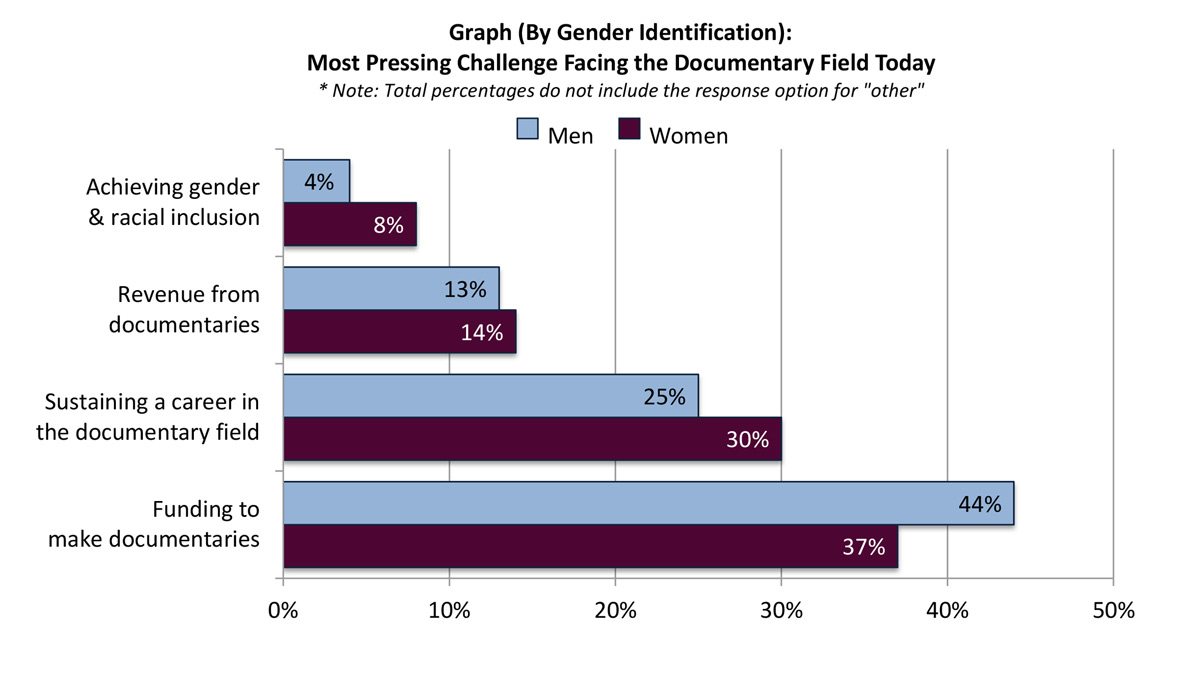
CAREERS & FUNDING: Sustaining a Documentary Career & Funding The Work
Education & Training for Documentary Work
Almost 8 in 10 documentary film professionals believe that the on-the-ground work of documentary production is the most valuable source of training for the craft; a combined 78 percent say working on their own documentary films (53%) or working on others’ documentary films (25%) is the most valuable.
Survey Question: Which of the following was your most valuable form of training for documentary filmmaking? [select one]

Salaries from Documentary Work
Revealed across multiple measures, these professionals are investing their own money into their documentary projects and often not seeing a return in the way of salary. Combined, more than two-thirds (66%) of documentary professionals made either no salary at all, or less than 50 percent of their salary, from their most recent documentaries.
Survey Question: Thinking about your last documentary (either full-length or short), please indicate how much of your own money you spent on the film.
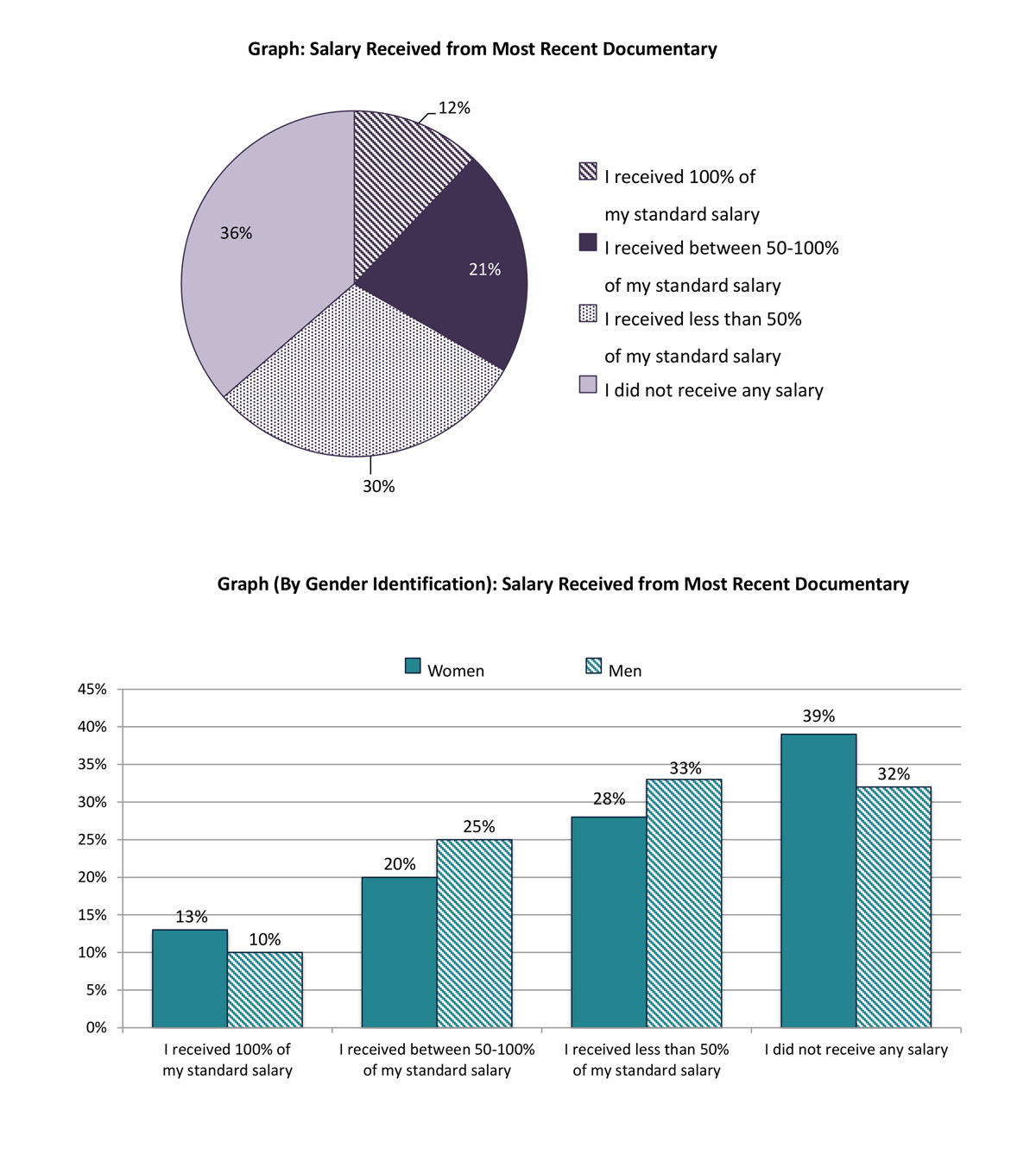
Investing Personal Funds in Documentary Work
Half (50%) of the documentary film professionals surveyed reported spending $5,000 to $50,000 on their most recent documentary projects. More than a quarter (27%) spent between $20,000 and $50,000 to fund their documentary work. We might assume this pattern might be a function of starting out in the industry, but it’s worth noting that this pattern doesn’t change as a documentary professional continues on in the field for a number of years, at least for these respondents. Even for documentary professionals in the field for 16 and up to 20 years, putting in personal money is a continuing practice.
Survey Question: Thinking about your last documentary (either full-length or short), please indicate how much of your own money you spent on the film.
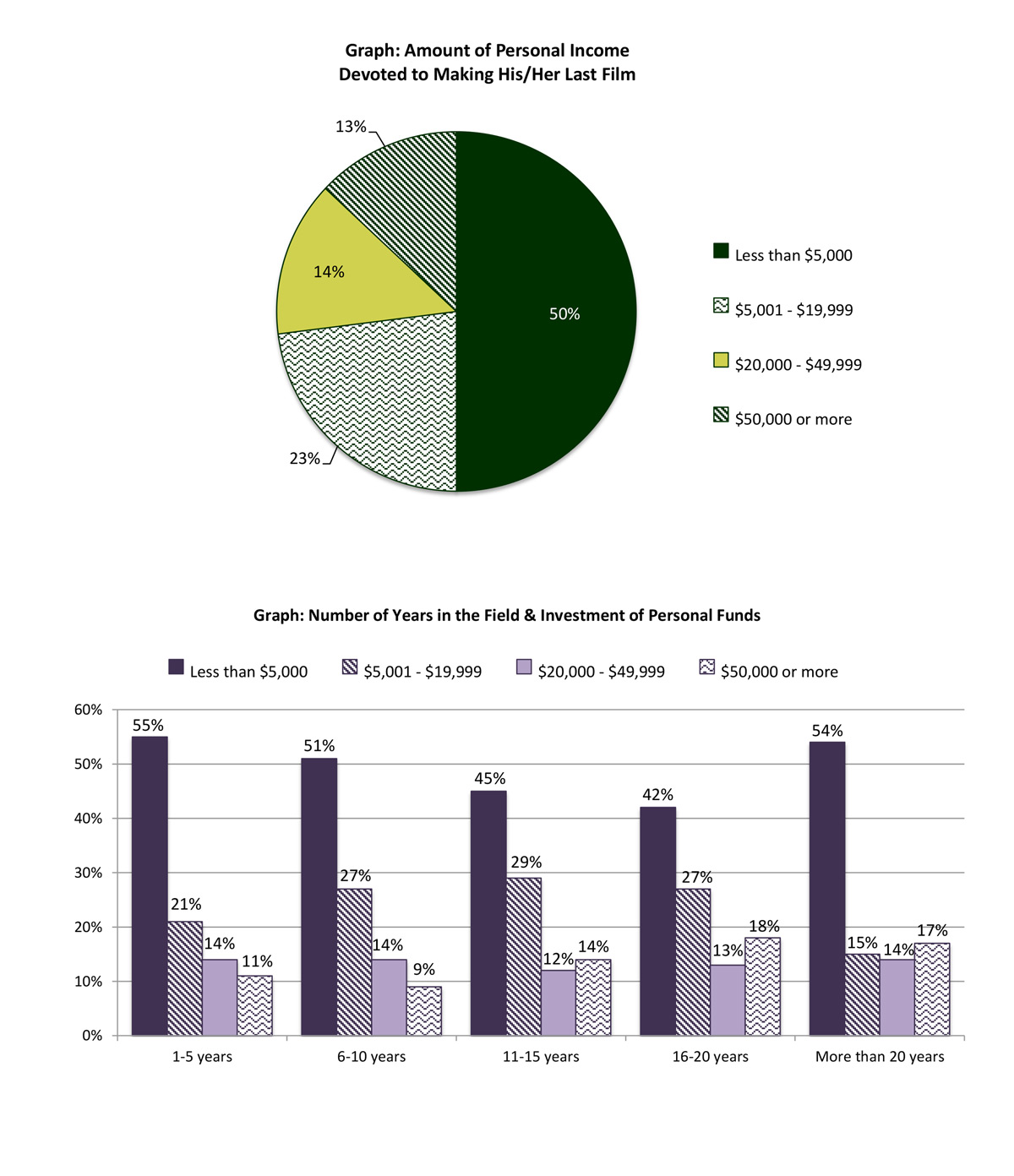
Documentary Funding Sources
For documentary work, there is no dominant or single source of funding. Foundation grants remain the top option as a main source of funding (33%), followed by personal finances (24%) and TV deals (21%). Entities that are not at all sources of documentary funding, according to these documentary professionals, are film studios, online streaming platforms and corporate funders. In terms of the most important contributing source of funding, “individual donors (not crowd-funding)” tops the list; 47 percent of documentary professionals note this. Notably, investments/equity, important funding streams for scripted films, is noted as “not at all a source of funding” by more than three-quarters (76%) of documentary industry respondents. And finally, online streaming platforms (like Netflix Originals) barely register; 92 percent of documentary professionals say this is not a source of documentary funding at all – this may really mean “not yet” and is worth tracking over time.
Survey Question: For your most recent full-length (broadcast or feature-length) documentary, was each source below a main source of funding, a contributing (not sole) source of funding, or not a source of funding?
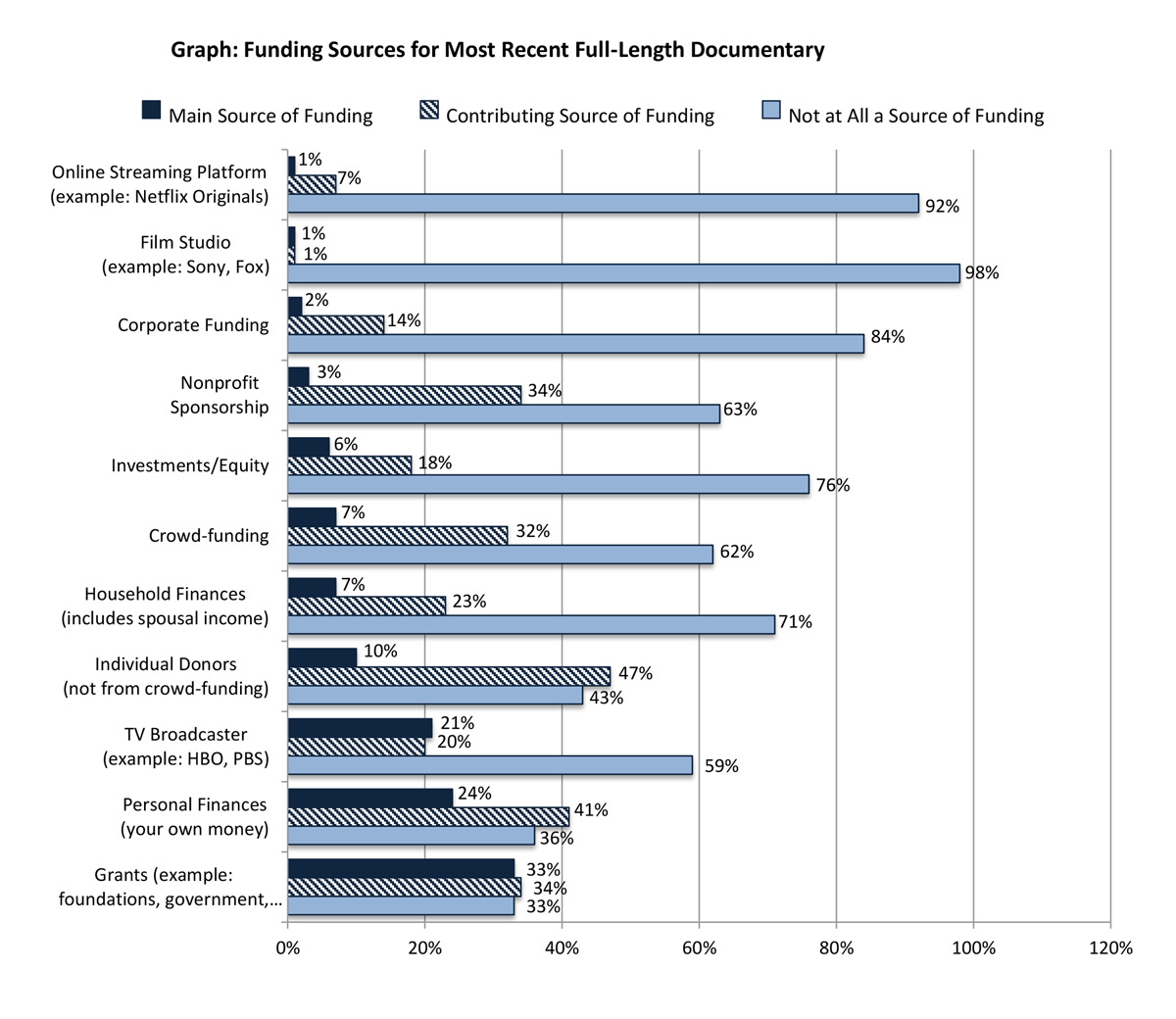
Documentary Revenue Streams
Where do documentary professionals make money? Documentary film professionals find revenue from their documentary work through a mix of non-film-industry sources and some traditional industry streams.
About 61 percent of documentary professionals say educational distribution and DVD sales are tied at the top of the list for revenue from documentary work (as a contributing or main source of revenue).1 Other top revenue streams (as contributing or main sources of revenue), in order, are: grassroots and community screenings (52%), speaking engagements (49%), international TV broadcast licensing (46%), and self-distribution (44%).
Spotlight on TV deals: Of the three TV categories (public TV, cable TV, premium subscription cable), public television ranks best in terms of revenue streams, with 32 percent of respondents saying public broadcasting offers “main” and “contributing” sources of revenue, relative to 18 percent who say this about cable TV, and 9 percent who make this claim about premium cable TV (HBO).
Survey Question: For your most recent full-length (broadcast or feature-length) documentary, was each distribution revenue source below a main source of revenue, a contributing (not sole) source of revenue, or not a source of revenue?

Funding Available for Development, Production, Post-Production, Outreach
In terms of available funding across the documentary creation life cycle – development and pre-production, production, post-production and outreach/distribution – perspectives vary. Most believe the funding is least adequate in a documentary’s development phase, with 61 percent saying funding to breathe life into a film is “not at all adequate.” Documentary professionals are most likely to feel that funding available during post-production is adequate. [The paradox of documentary film funding is the increased need for polished clip reels or rough scene edits in order to garner grant and other funding; without development funding to produce this early footage, documentary makers can be stuck in a catch-22 that requires early investment of personal funds.]
Survey Question: For each stage of documentary filmmaking, how adequate is the available funding?
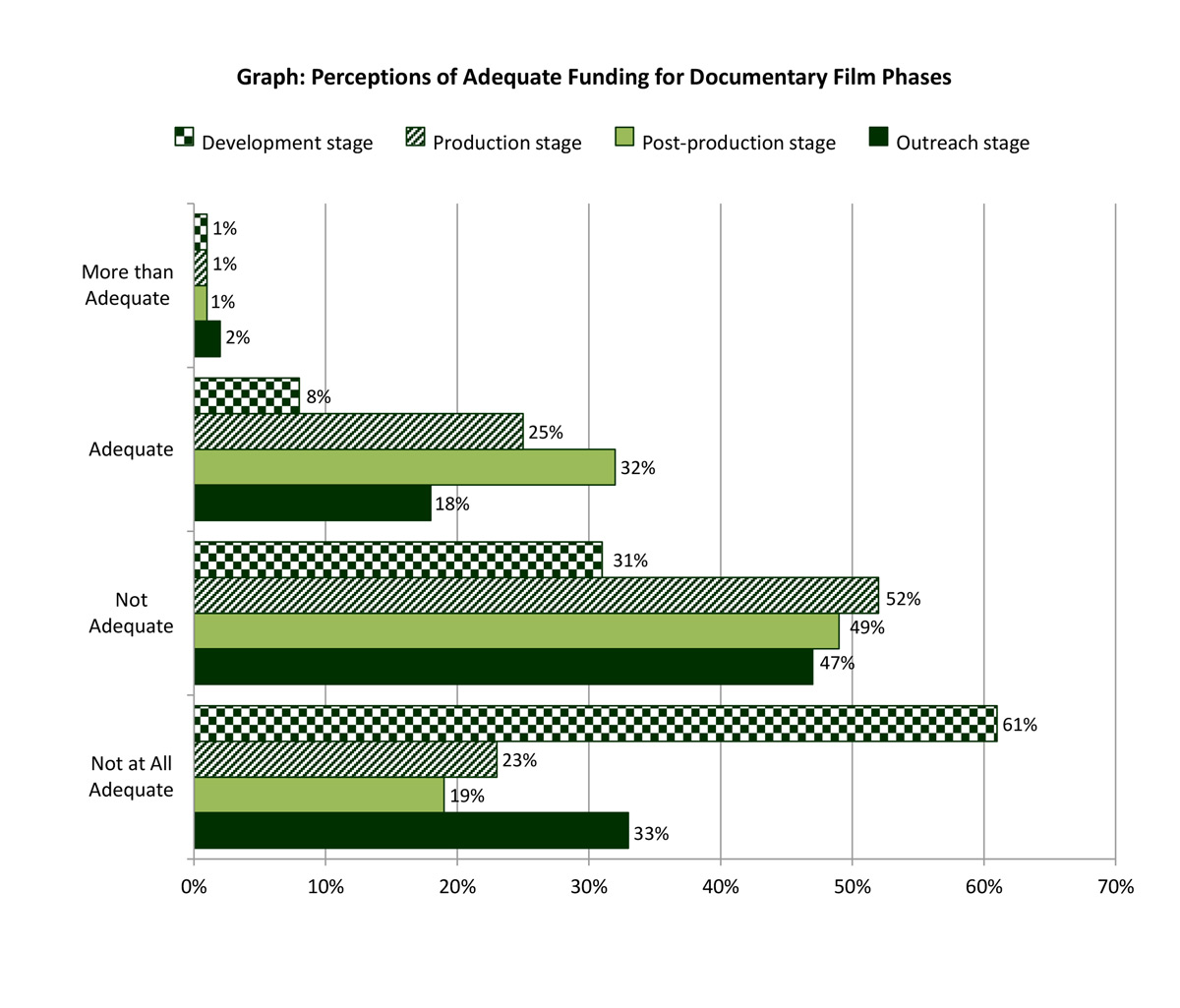
DISTRIBUTION & FORMAT: Getting Seen
Full-Length Films & the Festival Circuit
Most documentary filmmakers still predominantly create full-length stories (feature-length or :60 broadcast length); more than two-thirds (66%) produced a long-form documentary as their most recent film project. In terms of distribution, film festivals top the list (74%), followed by grassroots/ community screenings and educational screenings (both 49%), DVD sales (43%) and public TV (39%).
Survey Question: How would you characterize the last documentary you made (within past two years)?

Survey Question: How was your most recent full-length (broadcast or feature-length) documentary distributed? [select all that apply]

Working in Documentary’s Future-Looking Formats
Documentary professionals are motivated to work on new and evolving formats, including: Web-only documentaries (45 percent have not worked in this format but plan to do so), virtual reality (45 percent have not worked in this format but plan to do so), and scripted film and TV (32%).
Survey Question: Have you worked, or do you plan to work, in the following forms?
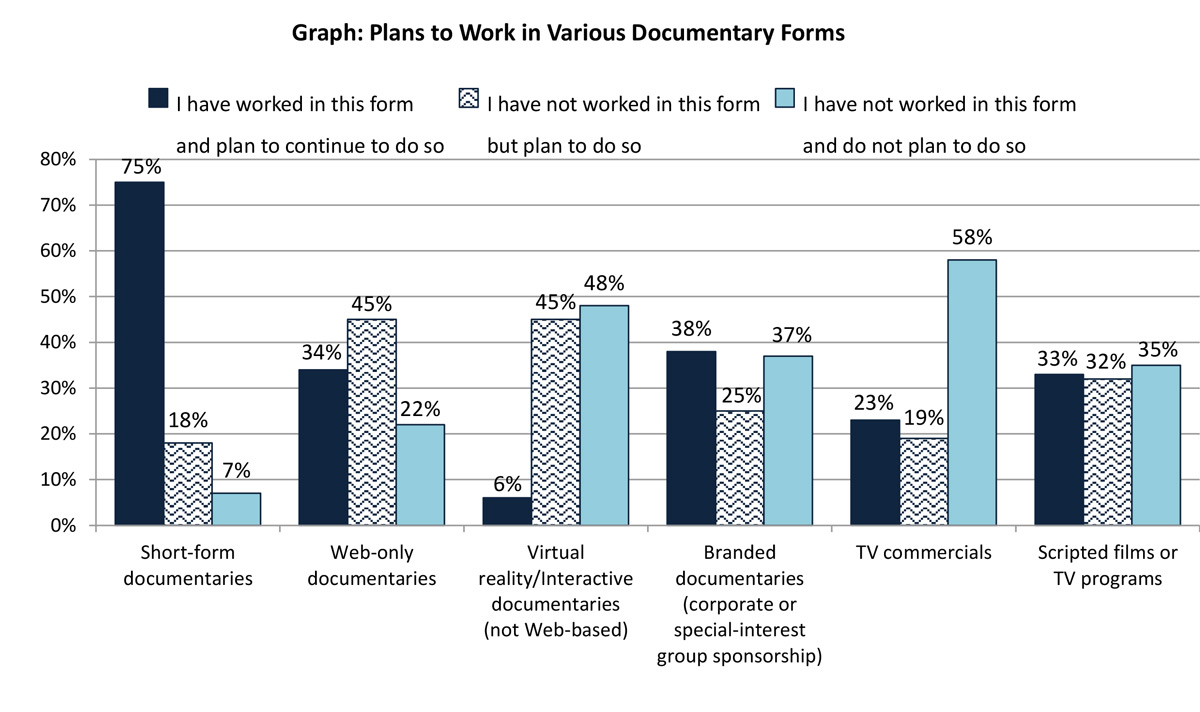
DIVERSITY & INCLUSION: Race & Gender On & Behind the Camera
Perceptions About Progress in Diversity & Inclusion in Documentary Work
Despite well-documented challenges of achieving greater levels of racial and gender diversity both in documentaries and among the individuals who make them, documentary professionals see the progress in the representation of people of color in documentary stories (83% see this in terms of making some and a great deal of progress). Documentary professionals see the greatest challenge in this area in terms of people of color as producers and directors: Almost half (47%) believe there’s been no progress or not much progress on the inclusion of directors of color, and 56 percent feel the same way about including producers of color.
In terms of gender, 84 percent of documentary professionals believe “some” or “a great deal” of progress has been made for women documentary directors, and almost 9 in 10 (87%) perceive “some” or “a great deal” of progress has been made for women documentary producers.
[It’s important to note here, however, that perceptions of progress in gender and racial inclusion – captured via survey research – should be coupled with the numerical reality of progress – in the form of content-based studies that can provide specific information about race and gender diversity in documentary film and TV. Please see two recent studies from the Center for Media & Social Impact: “Journey to the Academy Awards: An Investigation of Academy-Award Shortlisted and Nominated Documentaries (2014-2016)” and “Diversity in Independent TV Documentaries: Is Public TV Different?”]
In terms of three particular areas facing LGBT directors, producers, and representation of LGBT characters/stories on screen, the majority of respondents feel progress is being made on all three areas: 70 percent indicated some and a great deal of progress for LGBT directors, 67 indicated perceptions of this level of progress for LGBT producers, and 86 percent indicated this level of perception about LGBT stories on screen in documentaries.
Survey Question: Thinking about increasing diversity in the documentary field, to what extent do you feel progress is being made in each of the following areas?


ACTIONABLE OPPORTUNITIES & NEXT STEPS
The world of documentary professionals and aficionados is continuing to evolve at a moment of transition and opportunity.
Generally speaking, documentary professionals are motivated by their craft and looking toward the future. They are interested in working in future and evolving forms, and they are articulating layered revenue streams – some traditional in the film business, some focused on community and educational engagement in customized marketing models. They are motivated, also, by documentary’s social justice and social change imprint, no small feat in a fractionalized, niche-oriented news media environment. They are also thinking about diversity and inclusion – expanding opportunities for underrepresented filmmakers of color and women in particular.
Challenges remain, but the data also point to potential solutions and actionable opportunities, or at least areas that deserve to be studied and discussed further. These include:
- Revenue streams are found primarily in educational and grassroots and community screenings. Developing a strong and available set of resources, in the form of precise models and how-to information, would aid documentary professionals in their quest to make primary livings – revenue and salary – from their work. Future research and discussion might do well to focus on pulling together precise models to illustrate what works – in terms of layered distribution and specific revenue streams – to identify sustainable, career-making models.
- A disparity exists between documentary professionals’ perception of progress in the ranks of directors of color and women, and the actual reality of this progress. By juxtaposing this survey data with other studies that reveal very serious disparities in the inclusion of women and makers of color,2 a clear pattern emerges. The documentary community should support additional studies that examine the numerical/proportional reality of indices of gender and racial inclusion in the documentary profession – assessing perceptions alone will not move the issue forward.
- Given that the strong majority of documentary professionals feel that learning on the job is their most important training, this can be a valuable connector to the continuing challenge of diversity and inclusion for women and people of color. While traditional educational paths like film school continue to be valuable, creating opportunities to identify and place individuals onto existing documentary projects can provide both mentorship opportunities and the real-world experience that documentary professionals see as so valuable. There are, of course, several excellent examples of mentorship programs already at work in the documentary arena, so this highlight is meant to both validate and provide evidence of the need for more. Over time, this might prove an invaluable factor in continuing to combat this particular challenge through more than one avenue.
- Although documentary professionals indicate optimism and excitement about working in the newest formats – short-form for online distribution, streaming, etc. – there’s not yet a connection between these formats and funding streams. Consider that a strong majority of respondents indicated interest in working on documentary projects for streaming outlets and other online, and yet, when asked about funding sources, these formats barely register (92 percent of respondents said streaming platforms offer no funding at all).
- As the evolution continues and demand increases for short-form and online-only documentary content – and work developed first and only for streaming platforms – it is vital to curate details about financial transactions involved. Are these formats connected to career-sustaining revenue streams? At the moment, this seems to be an open question with a set of answers not yet fully and systematically available to all documentary filmmakers. As with other remaining questions, systematic research, information gathering and transparency can help create precise models with real information.
Each of the four main themes examined in this study may deserve its own committed set of research and information-gathering questions to explore over the next two years. This survey alone, while pointing to important trends and realities, should serve as a jumping-off point rather than the exclusive source of insights about the field. A focused workflow for each area, with a commitment to additional research to fill in unanswered questions, will be an important contribution as the field and its players continue to evolve in the months and years to come.
- Retroactively, we recognized that “educational distribution” and “DVD sales” could be redundant in some ways, as educational distribution often takes place in the form of DVD sales. As this is the first iteration of this particular survey instrument, we are committed to identifying phrasing in questions and responses that might need further clarification in subsequent iterations of this ongoing trend study. This disclaimer notwithstanding, both educational distribution and DVD sales reside firmly at the top of the list in terms of revenue streams identified by survey respondents. They are, therefore, worth serious consideration in perhaps creating a resource guide with functional revenue stream models and paths for documentary professionals. (We believe the same level of scrutiny in phrasing and delineation is important for the various “grassroots and community screenings” responses offered, as well, particularly as this survey data becomes useful material from which to build precise revenue models for documentary professionals to consider.)
- To understand current findings about the numerical reality of race and gender diversity in documentary work, see two recent studies from the Center for Media & Social Impact:
(1) “Journey to the Academy Awards: An Investigation of Academy-Award Shortlisted and Nominated Documentaries (2014-2016)” and
(2) “Diversity in Independent TV Documentaries: Is Public TV Different?”
